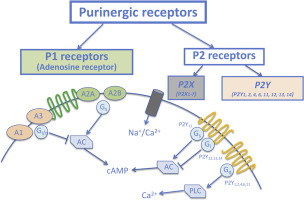当前位置:
X-MOL 学术
›
J. Mol. Cell. Cardiol.
›
论文详情
Our official English website, www.x-mol.net, welcomes your feedback! (Note: you will need to create a separate account there.)
Alteration of purinergic signaling in diabetes: Focus on vascular function.
Journal of Molecular and Cellular Cardiology ( IF 5 ) Pub Date : 2020-02-11 , DOI: 10.1016/j.yjmcc.2020.02.004 Rui Zhou 1 , Xitong Dang 1 , Randy S Sprague 2 , S Jamal Mustafa 3 , Zhichao Zhou 4
Journal of Molecular and Cellular Cardiology ( IF 5 ) Pub Date : 2020-02-11 , DOI: 10.1016/j.yjmcc.2020.02.004 Rui Zhou 1 , Xitong Dang 1 , Randy S Sprague 2 , S Jamal Mustafa 3 , Zhichao Zhou 4
Affiliation

|
Diabetes is an important risk factor for the development of cardiovascular disease including atherosclerosis and ischemic heart disease. Vascular complications including macro- and micro-vascular dysfunction are the leading causes of morbidity and mortality in diabetes. Disease mechanisms at present are unclear and no ideal therapies are available, which urgently calls for the identification of novel therapeutic targets/agents. An altered nucleotide- and nucleoside-mediated purinergic signaling has been implicated to cause diabetes-associated vascular dysfunction in major organs. Alteration of both purinergic P1 and P2 receptor sensitivity rather than the changes in receptor expression accounts for vascular dysfunction in diabetes. Activation of P2X7 receptors plays a crucial role in diabetes-induced retinal microvascular dysfunction. Recent findings have revealed that both ecto-nucleotidase CD39, a key enzyme hydrolyzing ATP, and CD73, an enzyme regulating adenosine turnover, are involved in the renal vascular injury in diabetes. Interestingly, erythrocyte dysfunction in diabetes by decreasing ATP release in response to physiological stimuli may serve as an important trigger to induce vascular dysfunction. Nucleot(s)ide-mediated purinergic activation also exerts long-term actions including inflammatory and atherogenic effects in hyperglycemic and diabetic conditions. This review highlights the current knowledge regarding the altered nucleot(s)ide-mediated purinergic signaling as an important disease mechanism for the diabetes-associated vascular complications. Better understanding the role of key receptor-mediated signaling in diabetes will provide more insights into their potential as targets for the treatment.
中文翻译:

糖尿病患者嘌呤能信号的改变:专注于血管功能。
糖尿病是发展为包括动脉粥样硬化和局部缺血性心脏病的心血管疾病的重要危险因素。包括大血管和微血管功能障碍在内的血管并发症是糖尿病发病率和死亡率的主要原因。目前的疾病机制尚不清楚,尚无理想的疗法,迫切需要鉴定新的治疗靶标/药物。涉及核苷酸和核苷介导的嘌呤能信号转导的改变已导致在主要器官中引起糖尿病相关的血管功能障碍。嘌呤能P1和P2受体敏感性的改变而不是受体表达的改变说明了糖尿病的血管功能障碍。P2X7受体的激活在糖尿病引起的视网膜微血管功能障碍中起着至关重要的作用。最近的发现表明,胞外核苷酸酶CD39(一种水解ATP的关键酶)和CD73(一种调节腺苷更新的酶)均与糖尿病的肾血管损伤有关。有趣的是,通过响应生理刺激而降低ATP释放,糖尿病患者的红细胞功能障碍可能是诱发血管功能障碍的重要诱因。核苷类介导的嘌呤能活化也可发挥长期作用,包括在高血糖和糖尿病情况下的炎症和动脉粥样硬化作用。这篇综述强调了有关改变核苷酸介导的嘌呤能信号转导作为糖尿病相关血管并发症的重要疾病机制的当前知识。
更新日期:2020-02-12
中文翻译:

糖尿病患者嘌呤能信号的改变:专注于血管功能。
糖尿病是发展为包括动脉粥样硬化和局部缺血性心脏病的心血管疾病的重要危险因素。包括大血管和微血管功能障碍在内的血管并发症是糖尿病发病率和死亡率的主要原因。目前的疾病机制尚不清楚,尚无理想的疗法,迫切需要鉴定新的治疗靶标/药物。涉及核苷酸和核苷介导的嘌呤能信号转导的改变已导致在主要器官中引起糖尿病相关的血管功能障碍。嘌呤能P1和P2受体敏感性的改变而不是受体表达的改变说明了糖尿病的血管功能障碍。P2X7受体的激活在糖尿病引起的视网膜微血管功能障碍中起着至关重要的作用。最近的发现表明,胞外核苷酸酶CD39(一种水解ATP的关键酶)和CD73(一种调节腺苷更新的酶)均与糖尿病的肾血管损伤有关。有趣的是,通过响应生理刺激而降低ATP释放,糖尿病患者的红细胞功能障碍可能是诱发血管功能障碍的重要诱因。核苷类介导的嘌呤能活化也可发挥长期作用,包括在高血糖和糖尿病情况下的炎症和动脉粥样硬化作用。这篇综述强调了有关改变核苷酸介导的嘌呤能信号转导作为糖尿病相关血管并发症的重要疾病机制的当前知识。


























 京公网安备 11010802027423号
京公网安备 11010802027423号